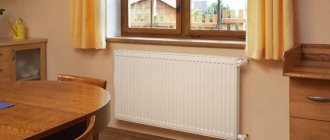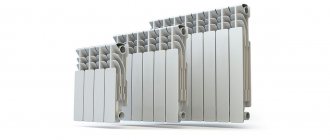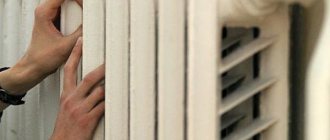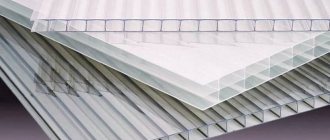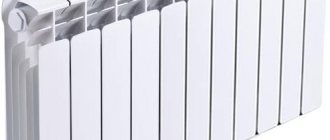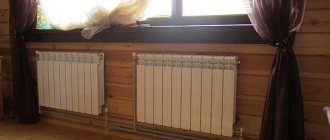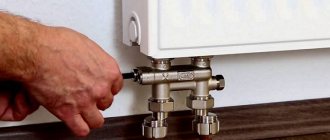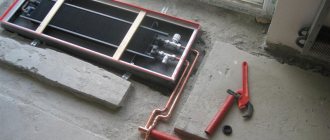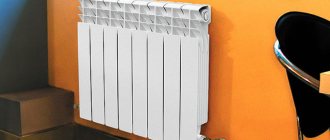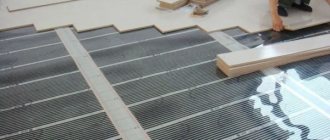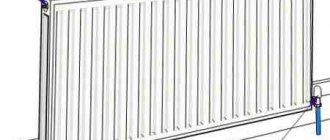Characteristics of cast iron radiators
- The material used is resistant to corrosion.
- Due to the resistance of cast iron to physical influences, batteries are used with any type of coolant. Its maximum temperature can be 150 degrees. A distinctive feature is its resistance to oxidation, because cast iron does not react when in contact with water, even if the acid-base balance reaches 9-10 Ph.
- It perfectly accumulates heat, which increases its heat transfer when compared with other materials. Cast iron batteries retain heat for a long time after the coolant supply is turned off.
- The durability of heating devices is up to 30 years. With proper installation and care, climate control equipment will last longer than expected.
- Thick walls are the reason why cast iron radiators live a long life.
- The number of sections can be varied to achieve the desired level of heating.
- If one section is damaged, only replace it, and not the entire battery.
The design of modern heating devices differs from the usual old “accordions” that are found in some apartments. Devices created using artistic casting and made in retro style are popular.
Suitable for three types of connection.
- Lower.
With this connection, the pipes are connected to the lower outlets on both sides. The disadvantage of the lower connection is low circulation. - Side.
This connection method provides for maximum coolant circulation, since the pipes are connected to the outer section into the lower and upper outlets of one side. - Upper.
The pipes are connected to the upper outlets of the outer sections. The circulation with this connection is much higher than with the lower one.
Cast iron radiators are cast from an alloy of homogeneous mass, intended for use in heating systems of apartment buildings. Sections are manufactured separately and connected using engineered gaskets and nipples for tightness.
The heater power stated in the technical specifications almost always differs from the actual one. This is due to the testing of the radiator in laboratory conditions, which differ from real ones.
The heated coolant flows through the pipes of the heating system into the radiator compartments and heats the air in the room, releasing heat.
Technical characteristics of cast iron radiators
Cast iron batteries are manufactured using a method such as casting. Cast iron alloy, first of all, is distinguished by the fact that it has a homogeneous composition. Such radiators are best suited for autonomous heating systems or central heating systems. You can choose different sizes of cast iron heating radiators.
Among the advantages of cast iron radiators are the following:
Technical characteristics of bimetallic heating radiators
- Resistant to corrosion. Cast iron is a material that is practically not affected by corrosion. Such heating radiators are able to withstand high coolant temperatures, up to +150 degrees.
- Cast iron radiators can be used for coolant of any quality. They can even be used for systems that use coolant with a high content of various alkalis. Cast iron is a material that is not easily scratched or dissolved.
- Cast iron batteries are made with thick walls. Thanks to this, such devices are able to last such a long period of time. Cast iron radiators can be used both for open heating systems and for those systems that are emptied from time to time. For example, steel radiators in such conditions will begin to become covered with rust after 2-3 years or may even burst.
Cast iron batteries have thick walls
- Cast iron batteries have excellent heat storage properties. If an hour passes from the moment the heating is turned off, the cast iron radiator will radiate about 30% of the heat. If we compare cast iron radiators with other types, the heat transfer from cast iron heating radiators will be several times higher. Cast iron radiators are ideal for systems in which heating of the coolant is irregular.
- Cast iron radiators have a fairly large cross-section. This means that they do not need to be cleaned very often.
- Cast iron radiators have the longest service life. Manufacturers of such devices are somewhat modest when they indicate the service life of cast iron heating batteries. Based on what manufacturers indicate, cast iron radiators should last from 10 to 30 years, but such heating devices often served their owners for half a century. If you use a good quality coolant, then the cast iron radiator may well celebrate its centenary.
Cast iron radiators also have some disadvantages. The main one is the rather large weight of the radiators.
The surface area of a cast iron heating radiator is slightly reduced due to sectioning. The area of a cast iron heating radiator will be slightly smaller than aluminum and others. According to this indicator, such radiators are inferior not only to aluminum or bimetallic, but also to steel devices. If you live on one of the upper floors, and it is prohibited to transport such objects in the elevator, then transporting such a radiator to the apartment will be an extremely difficult undertaking.
Cast iron radiators are characterized by heavy weight
Another disadvantage is that, compared to bimetallic radiators, they are not able to withstand high operating pressure. By comparison, cast iron batteries can withstand pressures of up to 15 atmospheres, while bimetallic devices can withstand 40 atmospheres.
Types of cast iron radiators
- Single channel.
In the design of radiators of this type, each section has a channel through which the coolant circulates. Climate control devices of this type are easy to clean, which is why they are installed in medical institutions. - Two-channel.
In one section of heating devices of this type there are 2 channels, which increases heat transfer. - Three-channel.
The heat transfer rates are higher compared to other species, while their weight and depth are much greater than those of their counterparts.
Two- and three-channel heating radiators use fins, which increase heat transfer. Sections can be stylized in different styles, from retro to futuristic. Sometimes a metal casing is used to hide the battery.
Double-channel heating radiators are popular because they are compact and have good heat dissipation.
Cast iron heating radiators are divided according to installation method:
- Wall-mounted.
They are mounted on walls using reinforced brackets; this type of fastening is classic. - Floor-standing.
The batteries are supplied with four legs. They are part of the outer sections, so they are difficult to break off. These do not require additional fasteners, which will save the wall. In addition, not all walls can withstand cast iron. It is more convenient to clean after them, since the distance from the wall can be much greater than with classic types of fastenings.
In height, on average, sizes range from 35 to 150 cm. The length depends only on your preferences, because the number of sections can be different, and the width directly depends on the number of channels.
External design features
Cast iron radiators are produced only in factory conditions; gray cast iron is used for these purposes. The radiator is made up of separate sections or “teeth”, each containing a round or oval shaped channel through which the coolant will move . Sections can be single-channel or double-channel. The sections are assembled into one battery, they are joined together, and heat-resistant gaskets are laid for tightness . The size of the battery will depend on the number of sections.
The size is selected individually depending on the area of the room, insulation and the number of window and door openings in the house. The size of radiators can vary from 50 to 140 centimeters in depth, from 35 to 150 centimeters in height, the width is chosen based on the number of sections.
The batteries are made using the casting method , so the design is sealed and reliable. Cast iron perfectly accumulates and releases heat, suitable for autonomous and centralized heating systems. Cast iron batteries have a high wear resistance and service life , withstand pressure surges well, the operating pressure in the battery is 9 atmospheres. They are not picky about the coolant; fine sand and scale when hot water moves cannot cause significant damage to the channels inside the sections. For central heating systems, where the coolant “acquires” a good supply of chemical elements during its journey, cast iron is also suitable, since the metal does not react and does not rust.
Disadvantages of cast iron radiators
- Weight.
This is the main disadvantage for cast iron products, and radiators are no exception. Because of the weight, and not because of aesthetics, the production of batteries with “legs” began, because not every wall is capable of supporting the considerable weight of cast iron. - Thermos effect.
They are classified as pros and cons. Cold radiators take a long time to warm up. When the heating is turned off, cast iron, due to the same property, remains warm for a long period of time and continues to give off heat. - Water hammer.
Some models of cast iron heating devices cannot withstand water hammer. The shocks occur in apartment buildings connected to a centralized heating system. This can be solved by installing a pressure regulator. - Pollution.
Cast iron batteries collect a lot of dust, and the design does not always allow for complete and high-quality cleaning. - Appearance.
Externally, cast iron devices are attractive, however, it is worth paying extra for beauty. Products made from this metal are sold unpainted, so the appearance is not attractive.
Ways out of this situation:
Paint the battery yourself.
A painted battery may look unsightly if the layers of paint are applied unevenly.
Install a grill over the climate control unit.
With the help of metal covers, you can “hide” the battery from prying eyes, however, such covers reduce the quality of heat transfer, and the room becomes cooler.
Order a cast iron radiator made in the style of an artistic cast.
Batteries cast in a variety of styles do not require painting. This radiator is not suitable for all interiors.
Features of cast iron radiators
Cast iron radiators appeared in our country only in the last century. The first city in which such a heating device was seen was St. Petersburg.
Such radiators are made from a fairly strong cast iron alloy. This material is very durable. Cast iron radiators are used both in residential buildings, industrial buildings, and in centralized heating systems. The battery can consist of any number of sections. This allows you to install the appropriate device for each room. For a small area, the power of a small radiator is enough, so it would be inappropriate to use a multi-section heating device. To avoid leakage, sealing gaskets made of rubber or other materials are used at the junctions of sections.
Cast iron radiators do not differ in the nature of their operation from steel or aluminum ones. The coolant is heated in the boiler and transfers its heat using a heating radiator. There are several models of cast iron radiators: with one, two or three channels.
Calculation of sections of cast iron radiators
Before purchasing a cast iron unit, you will need calculations that will allow you to more accurately determine the required number of sections. The example uses the following data:
1. The amount of heat generated by one section is 145 watts (the average figure is taken, the exact data is in the product data sheet). 2. The calculation is made for a room with normal insulation, one street wall and one window. According to SNiP, the amount of heat required to heat it is 100 watts. 3. The dimensions of the room are 4 x 3 meters.
Calculation
1. The area of the room is determined. It is equal to 12 m2. 2. Multiply the area and the amount of heat needed to heat one square meter of room. According to SNiP, the room in the example requires 100 watts/m2. After performing this action, you get 1200 watts. 3. The amount of heat required for the room must be divided by the heat transfer of one part of the battery. Afterwards, round the result up. 4. The number of sections required for installation is obtained. For the room indicated in the example, a radiator consisting of 9 sections is installed.
The calculation is focused on rooms whose height does not exceed 3 meters.
Since each room is unique, there are coefficients that allow more accurate calculations:
To accurately measure the amount of heat per square meter, you need to divide the ceiling height by a factor of 3. For a room with a ceiling of 2.5 m, it will be 0.83.
For calculations, the average coolant temperature is used, which is 70 degrees. When this indicator increases, 15% must be subtracted from the final number every 10 degrees; when the temperature decreases, do the opposite.
If the room has not one, but 2 or 3 street walls, then it is worth multiplying the amount of heat for 1 m2 by a factor of 1.75. After this, the number of sections must be divided by the number of windows and radiators installed under each of them. This will ensure uniform heating of the entire room.
If the room has additional thermal insulation layers, as well as if double-glazed windows are installed, the amount of heat for 1 m2 is allowed to be divided by 0.8.
For houses located in regions with extremely low temperatures, the amount of heat per 1 m2 increases by 2 times.
Before installing a cast iron radiator, you need to disassemble it into sections, check the fastening of the nipples, and then reassemble it. You need to install it taking into account the weight of the battery and the material of the wall in the room. The minimum set of tools is an angle grinder, a hammer drill, an adjustable wrench, a building level and a die.
1. If the wall is brick or concrete, select fasteners that are designed to support the weight of the radiator with coolant. According to SNiP, the use of 3 or more brackets is recommended.
2. You cannot hang cast iron radiators on walls made of wood or plasterboard.
because they may not be able to withstand the load. In this case, you can install the radiator on a floor stand or legs. It is attached to the wall only to maintain it in an upright position.
After installing the radiator, it is connected to the central heating using connecting sleeves and a conduit. It is recommended to seal the threaded connections.
Cast iron radiators must be periodically tinted with paint that can withstand heating temperatures without changing color.
Connection to the heating system:
1. Diagonal
. Used when connecting multi-sectional units. The supply pipe is connected at the top on one side, and the return pipe at the bottom on the other.
2. Lower.
Used when pipes are hidden in the floor of a room or behind baseboards. This is an aesthetic way to connect. The supply and return pipes are located at the bottom.
3. Lateral
. The supply pipe is connected to the upper fitting, the return pipe to the lower one. The side connection has the greatest heat transfer. In case of poor heating in multi-section heating devices, it is recommended to install a coolant flow extension.
4. Consistent.
The coolant moves under the pressure of the heating structure. Mayevsky taps are used to remove air. The disadvantage is the need to remove batteries and turn off heaters during repairs.
5. Parallel.
The connection is made through a pipeline connected to the supply riser. The coolant leaves through a pipe connected to the return line.
Content
Cast iron is a classic material for the manufacture of heating appliances. It was from this that the first radiators of the pre-revolutionary era were made, some of which continue to function properly to this day. For a long time, cast iron radiators had no alternative in the USSR - steel radiators-convectors began to be actively installed in the central heating system only in the 70s. Cast iron batteries are made by casting. Improvements in technology have made it possible to improve the surface quality and a modern mass-produced heating device looks no worse than popular batteries made from other materials. But the most aesthetically pleasing is the appearance of cast iron products made using artistic casting technology - such batteries can become the highlight of the room. Let's consider the technical characteristics of cast iron heating radiators and their features.
Cast iron batteries Retro
Calculating the power of a cast iron radiator
You can calculate the number of sections for cast iron heating devices using a variety of methods. In specialized books there are methods that include a large number of factors, including the area of the room, the location of windows and doorways, the material and structure of the walls, technical indicators of batteries, etc.
However, you can obtain the desired value using a simpler formula: multiply the area of the room by 100 and divide by the power of one section.
The result obtained should be corrected as follows:
- In rooms with a height of more than 3 m, 1-2 sections are added to compensate for heat losses
- Adding several sections is necessary for rooms where two walls border the street
- In rooms with two window openings, radiators are installed under each of them, dividing the found number of sections equally. This is necessary so that air barriers are formed under the windows for cold through flows from outside.
- The fractional value is always increased in a positive direction
Design
Classic cast iron radiators are not much different in appearance. However, the development of the heating appliance market and the constant change in the style of the interior forced manufacturers to come up with something new, more elegant and extravagant.
Today, the market offers models of various color palettes (gold plated, silver, copper, bronze, etc.). There are radiators with artistic castings on which ornaments are applied.
However, external design significantly affects the cost. Decorative models are much more expensive than classic, modern aluminum, steel or bimetallic ones.
Video instructions for assembling sections
Let's sum it up
Having examined in more detail the features and technical characteristics of cast iron heating radiators, you can get your own idea about these heating devices. However, it is impossible to claim their great superiority over other models. The reason is that each of the proposed options has its pros and cons.
Due attention should be paid to cast iron models when designing a heating system. You can purchase them in a maintained condition to save money and not have to worry about them breaking down soon.
Types of cast iron radiators and their design features
When choosing cast iron radiators, first of all pay attention to their dimensions. If we are talking about reconstructing the system, then the heating device must fit the existing pipeline according to the distance between the connection holes. It must be installed under the window sill in compliance with the requirements regarding the gaps between the radiator and the window sill board, on the one hand, and the floor, on the other - it is important to ensure effective circulation of heated air. Its heat transfer depends on the dimensions and correct installation of a cast iron battery.
Design of cast iron radiators
Cast iron heating radiators from different manufacturers differ in the following parameters
:
- center-to-center distance (the space between the centers of the holes for connecting the pipeline) – from 220 to 900 mm;
- depth – from 85 to 200 mm;
- width – from 45 to 108 mm;
- height – from 330 to 954 mm.
To a certain extent, the dimensions of a heating device depend on the style in which it is made. The usual “accordion” is produced in Russia and the Republic of Belarus according to certain standards, which differ slightly from each other. Designer models from domestic and foreign manufacturers vary greatly in height and the presence of legs. In this case, the standard interaxle distance is observed.
Please note: unlike standard ones, designer radiators cannot always be expanded with additional sections. Manufacturers of designer radiators can also offer models designed for bottom connections.
Low radiators. This category includes heating devices with a height of 330 mm to 400 mm. The center distance for such models is 300 or 350 mm. Representatives of low cast iron radiators are the standard “accordion” MC-140M, as well as the designer BOLTON 220, Viadrus Hellas 270.
Variety of sizes and shapes of cast iron radiators
Medium radiators. The height of such heating devices ranges from 400 mm to 660 mm, the center distance is 500 mm, regardless of the model. The standard “accordions” MS-140, SM-110, MS-90, MS-85 are on sale. The marking indicates the depth of the section, while the width of the section can be 108 mm (for a manufacturer from Belarus) or 93 mm (for Russian manufacturers). Medium-sized designer radiators include cast iron heating devices of the DERBY M 500 and Modern 500 brands.
Tall radiators. These are models with a height of 660 mm, while the maximum height is 980 mm including legs. Designer heating devices in retro style are usually tall. Height restrictions are associated with the fragility and heavy weight of cast iron. In addition, the higher the section, the more thermal energy is required to warm it up.
Note! Manufacturers of stylized radiators may not indicate the depth of the product in the list of technical characteristics if the shape of the model is not linear.
The technical characteristics of the heating device depend on the dimensions. The dimensions and number of sections determine the battery power. At the same time, there is no point in increasing the “accordion” with additional links by more than 30%, since at the same time its heat capacity increases. As a result, heat transfer will not increase, but will decrease, since the coolant will not be able to provide high-quality heating of the entire radiator.
Cast iron radiators 7 sections
Technical features of cast iron radiators
The characteristics of cast iron heating radiators depend on the battery model. MS-140 is the most common model with a long service life .
MS-140 have impressive dimensions and a depth of 140 cm, a capacity of 0.12 to 0.16 cm, the coolant in the section is much greater than that of analogues (from 1.11 to 1.45 l), and an average weight of 7 kg. The heating surface area is 0.24 m2, the pressure is 9 atmospheres.
Main advantages
The advantages of a cast iron radiator traditionally include:
- Corrosion resistance. A feature of cast iron is its resistance to oxygen, due to which such heating devices can be used as part of open heating systems, as well as operate in the mode of regular filling and draining of coolant. Steel radiators quickly rust from the inside after the system is emptied and fail after 2–3 years of operation in “ragged” mode.
- Undemanding to the acidity level of the coolant. Cast iron batteries are not afraid of acidic or alkaline environments and are suitable for systems filled with antifreeze.
- High temperature resistance. The batteries can withstand heating of the coolant up to 150 C°. Such technical characteristics make the heating device suitable for gravity systems with a solid fuel boiler, where it is difficult to regulate the heating of the liquid.
- Quite a large internal cross-section. Thanks to this, washing is not required very often.
- Heat storage properties. Thick-walled cast iron radiators have an important property - they retain heat for a long time. After turning off the heating, the radiator will cool down gradually, and after an hour the thermal radiation will be approximately 30% of what it was when the boiler was stopped. The ability to retain heat in cast iron heating devices is several times higher than that of batteries made from other materials, which makes them the preferred choice for autonomous systems with a solid fuel boiler that requires loading fuel more than once a day.
- Durability. The thickness of the walls of cast iron batteries contributes to long-term operation, provided that the material is of high quality and optimal operating conditions. There are examples of successful operation of radiators made a hundred years ago, and examples with Soviet batteries that begin to “crumble” after 20–30 years of operation. Manufacturers estimate the service life of their products at 10–30 years, but in fact it can be much longer.
Cast iron radiator Demir Dokum (Türkiye)
Main disadvantages
Cast iron radiators are not without serious disadvantages, including:
- Heavy weight. The thick walls and size of cast iron heating radiators complicate transportation, especially if heating devices need to be raised to the upper floors of a multi-story building without an elevator. Installing batteries is problematic to do alone, especially if they are not installed on the floor, but attached to the wall.
- Features of the form. Due to the sectional nature of the cast iron battery, the surface area is relatively small when compared with other types of heating devices. The bulk of the heat is transferred by radiation, convection is practically absent, which slows down the heating of the room.
- Appearance. Old-style serial radiators can hardly be called aesthetically attractive; in addition, the batteries may require painting with special paint for radiators. It is important to remove the previous decorative layer so that the heat transfer of the battery does not decrease. If the battery is covered with a decorative screen for aesthetics, this also leads to a decrease in heat transfer.
- Thermal inertia. The same property is both a minus and a plus. Cast iron radiators cool down slowly, which may be needed in some cases, but cast iron radiators heat up very slowly when the heating is turned on. Due to thermal inertia, such heating devices cannot be used in a system with flexible temperature control in rooms. This means that they are not suitable for cost-effective independent heating systems.
- Fragility of the material. Cast iron may not withstand a pinpoint impact from a heavy object and may be damaged if dropped onto concrete or stone. During operation, microcracks expand under the influence of high temperatures, as a result of which the battery can leak. In the same way, cast iron is destroyed by sudden temperature changes.
- Tendency to overgrow. The rough inner surface promotes the accumulation of deposits. Since the internal cross-section is quite large, the battery will not become completely clogged for a long time, but its heat transfer will decrease. It is recommended to flush the heating devices of the autonomous system every few years.
- Large internal volume. The more coolant required to fill the system, the higher the energy consumption for heating it.
Cast iron radiator MS-140M
The disadvantages of cast iron radiators often include relatively low peak pressure compared to bimetallic heating devices. Cast iron batteries can withstand pressure surges of up to 15 atm, while bimetallic batteries can withstand pressure surges of up to 40 atm. However, in the central heating network the pressure does not rise above 15 atmospheres, thanks to which numerous cast iron batteries work perfectly for decades. And in the autonomous system the pressure is much lower than in the central one.
Brands and cost of cast iron batteries
When choosing heating devices made of cast iron, take into account the technical characteristics of the models and their aesthetic design. To calculate the required number of sections, the calculated power of the heating device for a specific room is required to be divided by the power of one section (indicated by the manufacturer).
Cast iron radiators DEMRAD RETRO
Cast iron radiators from the following manufacturers are popular in Russia:
- Minsk Heating Equipment Plant (Republic of Belarus). Manufactures MC series radiators. This is an analogue of Soviet batteries with a slightly improved design.
- "Santekhlit" (Russia). It also produces inexpensive MC series batteries made of gray cast iron. Some improvements have improved the technical parameters compared to the classic model.
- Viadrus (Czech Republic). Offers small radiators with an original modern design. Batteries require painting.
- Demrad (Türkiye). The product range includes heating units of different heights with a modern design, which are suitable for replacing old standard radiators.
- Demir dokum (Türkiye). Specializes in the production of retro-style batteries with legs. The products are characterized by increased heat transfer.
- Conner (China). Designer radiators created by Russian specialists and intended for the domestic market. They are distinguished by an attractive appearance, a variety of styles, and high heat transfer.
Cast iron radiator Viadrus Kalor
When planning to buy a cast iron radiator, please note that designer models are solid cast - in this case, the seller indicates the cost of the product. Also in stores, including online, batteries of 7 or 10 sections may be presented with a price tag for a one-piece radiator. In other cases, the price of one section is indicated. On average, one section of a cast iron battery costs from 400 to 600 rubles, depending on the size and manufacturer
.
The duration of the heating season in our latitudes is close to 2/3 of the year. The indicator depends on the region, but on average it is about 250 days. For us, all issues related to the efficiency of the heating system are extremely important, which largely depends on the correct choice of its devices.
Let's look at which heating radiators are better and what the different types are. The article presented for consideration describes in detail the criteria for selecting heating devices. For independent home DIYers, we have provided tips from experienced plumbers.
Regardless of the complexity of the heating system, the main task is to maintain the set temperature in the house or apartment. The heating radiator plays a key role in this, carrying out heat exchange between the air in the room and the coolant.
Uniform heating, efficient heat transfer, microclimate maintenance, stable operation - these are the basic requirements for a heating battery.
In residential premises, single, panel or sectional twin radiators are installed that do not emit toxins when heated
The main parameters influencing the choice of a specific model:
- System operating pressure.
Depends on whether the device is connected to an autonomous or centralized network. It is arranged on a gravity or forced principle. On average it varies from 3 to 10 bar or in a similar atmosphere range. - Thermal power.
A characteristic required to calculate the thermal power required to heat a room. It is also needed for selecting individual components of sectional batteries. Approximately 1 kW is required to process 10 m². - Modularity.
The quality inherent in prefabricated radiators, which makes it possible to assemble and disassemble the device to suit individual requirements. - Speed of reaction to tº.
More precisely, the ability to respond to changes in coolant temperature. period of time for cooling and warming up. - Possibility of equipping with automation.
Devices that monitor weather conditions and independently eliminate air jams.
The devices now available for sale ensure free circulation throughout the system. They are characterized by corrosion resistance and attractive appearance.
Sectional radiators differ in the shape and size of the sections, ensuring the supply of the required amount of thermal energy
The thermal efficiency of a radiator depends on the energy dissipation surface area. A flat metal convector has a much smaller area compared to a sectional aluminum convector of the same geometric size. Because the latter radiates heat over the entire area of the fins.
Types of modern heating radiators
During Soviet times, the question of which heating battery is better to choose was never asked for a simple reason. The industry produced only two types of them - steel and cast iron. We live in a fortunate time of diversity, technological and environmental excellence.
The global and domestic industry offers a fairly wide range to choose from. There are several signs according to which it is advisable to separate heating radiators.
Radiators can be divided according to materials of manufacture:
- steel panel convectors;
- cast iron batteries;
- aluminum radiators;
- bimetallic radiators.
By design features:
- sectional;
- panel.
Each of these types is best suited for its operating conditions, and therefore has its own nuances. A separate type of heating radiators is highly specialized. These are devices designed to solve one task, often to the detriment of overall functionality.
Image gallery
Conclusions and useful video on the topic
Useful tips from experts will help you understand the choice of heating device:
The best choice of heating radiator can be considered the one that achieves the greatest comfort and coziness. The radiator can be invisible or, on the contrary, be part of the overall design. But the most important thing is reliability and no hassle.
You can tell us about how you chose a radiator to replace old batteries in an apartment or to furnish a new home in the block below. Please write comments, ask questions, share useful tips and photos on the topic of the article. We are interested in your opinion.
The weight and dimensions of cast iron heating radiators will primarily depend on the number of sections in one device, but these same sections can also differ radically from each other, since they are single-, double- and triple-channel.
But, despite their bulkiness, cast iron batteries are in great demand for water central heating systems, as they fully comply with the necessary parameters for heat transfer and strength under any possible surges in coolant pressure.
It is these devices, familiar to probably every Russian citizen who has reached the age of conscious, that we will talk about, and we will also show you a video in this article.
Cast iron radiators
A cast iron radiator is a convection-radiation column heating device, which is assembled from several sections. It was invented by Franz San Galli in 1857.
Types and designs
- As we have already said, how much a cast iron heating radiator weighs, as well as its volume, directly depends on the number of sections, as well as on the number of channels in a particular section of this device. For example, we will consider such heaters from the ChM series, which are made in accordance with the requirements of GOST 8690-94. All of them are designed for installation taking into account the depth of the opening under the window, that is, small, medium and large depths, which can be filled based on the number of columns in the sections.
- Heating devices of the ChM series are designed for centralized water heating systems of residential, public and industrial buildings with a minimum operating pressure of 1.2 MPa (12.236 atm) and (test) pressure of 1.8 M Pa (18.354 atm) and a water temperature not exceeding 150 ᶷC (their the price is most affordable).
- Of course, the weight of cast iron heating radiators will also depend on the sections
from which it is assembled, and they are made of gray cast iron in a sand-clay form using the casting method, which allows the device to maintain stable performance for about 40 years or more. - Cast iron is a fairly resistant metal to low-quality coolant
, that is, water can have a high content of salts, alkalis and rust, but it is also porous, which contributes to the retention of various elements and sedimentation of sludge, so batteries need regular maintenance.
The complete set of the cast iron heating device also consists of two side plugs (left-hand thread G 1 ¼), as well as two fittings or, as they are also called, through plugs (G 1 ¼ right-hand thread) and a hole with left-hand thread G ¾ for heat pipe fittings. When joining sections together, steel nipples and heat-resistant rubber gaskets are used in accordance with TU 38.105376-92.
Note. One of the most negative factors that can characterize such heating devices is the weight of the cast iron radiator and its long heating time, which is why, strictly speaking, it is not used in autonomous heating systems - high energy consumption for boilers using any type of fuel. But at the same time, it gives off heat for a very long time, which makes it possible not to turn on pumps for water circulation so often, therefore, such batteries are almost ideal for centralized systems.
| Section parameter name | Digital designation | |||||
| World Championship1-70-300 | World Cup1-70-500 | World Championship2-100-300 | World Championship2-100-500 | World Championship3-120-300 | World Championship3-120-500 | |
| Number of channels | Single channel rectangular | Two-channel rectangular | Three-channel rectangular | |||
| Weight (kg) | 3,3 | 4,8 | 4,5 | 6,3 | 4,8 | 7,0 |
| Volume (l) | 0,66 | 0,9 | 0,7 | 0,95 | 0,95 | 1,38 |
| Heating surface area (m2) | 0,103 | 0,165 | 0,148 | 0,207 | 0,155 | 0,246 |
| 0,075 | 0,110 | 0,1009 | 0,1426 | 0,1083 | 0,1568 | |
| Installation height (mm) | 300 | 500 | 300 | 500 | 300 | 500 |
| Height (mm) | 370 | 570 | 372 | 572 | 370 | 570 |
| Depth (mm) | 70 | 70 | 100 | 100 | 120 | 120 |
| Width (mm) | 80 | 80 | 80 | 80 | 90 | 90 |
Table: technical characteristics of a cast iron radiator for one, two and three channels
| Designation World Cup-1 | Number of sections (pcs) | Heat Flux Rating (kW) | Weight, kg) | Radiator length (mm) | ||
| World Cup1-70-500-1,2-2 | 2 | 0,22 | 48,64 | 10,7 | 0,396 | 178-184 |
| World Cup1-70-500-1,2-3 | 3 | 0,33 | 47,58 | 15,7 | 0,594 | 258-265 |
| World Cup1-70-500-1,2-4 | 4 | 0,44 | 47,05 | 20,7 | 0,792 | 338-346 |
| World Cup1-70-500-1,2-5 | 5 | 0,55 | 46,73 | 25,7 | 0,990 | 418-427 |
| World Cup1-70-500-1,2-6 | 6 | 0,66 | 46,52 | 30,7 | 1,188 | 498-508 |
| World Championship1-70-500-1,2-7 | 7 | 0,77 | 46,36 | 35,7 | 1,386 | 578-589 |
| World Cup1-70-500-1,2-8 | 8 | 0,88 | 46,25 | 40,7 | 1,584 | 658-670 |
| World Championship1-70-500-1,2-9 | 9 | 0,99 | 46,16 | 45,7 | 1,782 | 738-751 |
| World Cup1-70-500-1.2-10 | 10 | 1,10 | 46,09 | 50,7 | 1,980 | 818-832 |
Table of characteristics of ChM-1-70-500-1.2
| World Cup 2 designation | Number of sections (pcs) | Heat Flux Rating (kW) | Specific material consumption (kg/kW) | Weight, kg) | Heating surface area (? t =70° C), ECM | Radiator length (mm) |
| 100-500-1,2-2 | 2 | 0,285 | 48,1 | 13,7 | 0,512 | 178-184 |
| 100-500-1,2-3 | 3 | 0,428 | 47,2 | 20,2 | 0,769 | 258-265 |
| 100-500-1,2-4 | 4 | 0,570 | 46,8 | 26,7 | 1,024 | 338-346 |
| 100-500-1,2-5 | 5 | 0,713 | 46,7 | 33,3 | 1,281 | 418-427 |
| 100-500-1,2-6 | 6 | 0,856 | 46,5 | 39,7 | 1,537 | 498-508 |
| 100-500-1,2-7 | 7 | 0,998 | 46,4 | 46,3 | 1,792 | 578-589 |
| 100-500-1,2-8 | 8 | 1,141 | 46,4 | 52,9 | 2,049 | 658-670 |
| 100-500-1,2-9 | 9 | 1,283 | 46,3 | 59,4 | 2,304 | 738-751 |
| 100-500-1,2-10 | 10 | 1,426 | 46,1 | 65,8 | 2,561 | 818-832 |
Table of characteristics of ChM-2-100-500-1.2
| World Cup 2 designation | Number of sections (pcs) | Heat Flux Rating (kW) | Specific material consumption (kg/kW) | Weight, kg) | Heating surface area (? t =70° C), ECM | Radiator length (mm) |
| 120-500-1,2-2 | 2 | 0,314 | 47,78 | 15,1 | 0,564 | 198-206 |
| 120-500-1,2-3 | 3 | 0,470 | 46,95 | 22,3 | 0,844 | 288-297 |
| 120-500-1,2-4 | 4 | 0,627 | 46,60 | 29,5 | 1,126 | 378-388 |
| 120-500-1,2-5 | 5 | 0,784 | 46,39 | 36,7 | 1,408 | 468-477 |
| 120-500-1,2-6 | 6 | 0,941 | 46,21 | 43,9 | 1,690 | 558-568 |
| 120-500-1,2-7 | 7 | 1,098 | 46,11 | 51,1 | 1,972 | 648-659 |
| 120-500-1,2-8 | 8 | 1,254 | 46,05 | 58,3 | 2,252 | 738-750 |
| 120-500-1,2-9 | 9 | 1,411 | 45,96 | 65,5 | 2,534 | 828-841 |
| 120-500-1,2-10 | 10 | 1,568 | 45,92 | 72,7 | 2,816 | 918-932 |
Table of characteristics of ChM-3-120-500-1.2
Assembly, disassembly
As we have already said, you can increase or decrease the heat transfer and volume of a cast iron heating radiator by adding or unscrewing sections, of which there can be from two to infinity, although it is unlikely that anyone will install more than 15 pieces.
Most often we have to deal with the two-column sections that you see in the top photo - they are connected using a nipple and a heat-resistant rubber gasket. The nipple inside has a rounded shape with two parallel planes, which allows you to fix the key head there, but the internal diameter can be either 1 ¼ ̎or 1 ̎.
In accordance with this, a key is selected, where the head can be flat or repeat the internal shape of the nipple - the instructions are silent on this matter. In order to unscrew one or more sections, you need to insert the key so that the head reaches the nipple, which is located at the junction, therefore, first it is placed on top of the battery to mark the immersion depth on the rod.
The forces applied to rotate using the gate are usually not enough, therefore, the lever is increased by cutting a pipe - the same lever is needed during assembly so that the connection does not leak.
Heat dissipation of a cast iron radiator
The power of a cast iron radiator directly depends on the area of its outer surface and lies in the ability to release heat energy at the highest possible coolant temperature. Basically, this value ranges from 80 to 200 watts per section . To calculate the required power, the following formula is used: for 25-30 cubic meters. m. battery power should be 1 kW . If there are several external walls, the power indicator increases.
